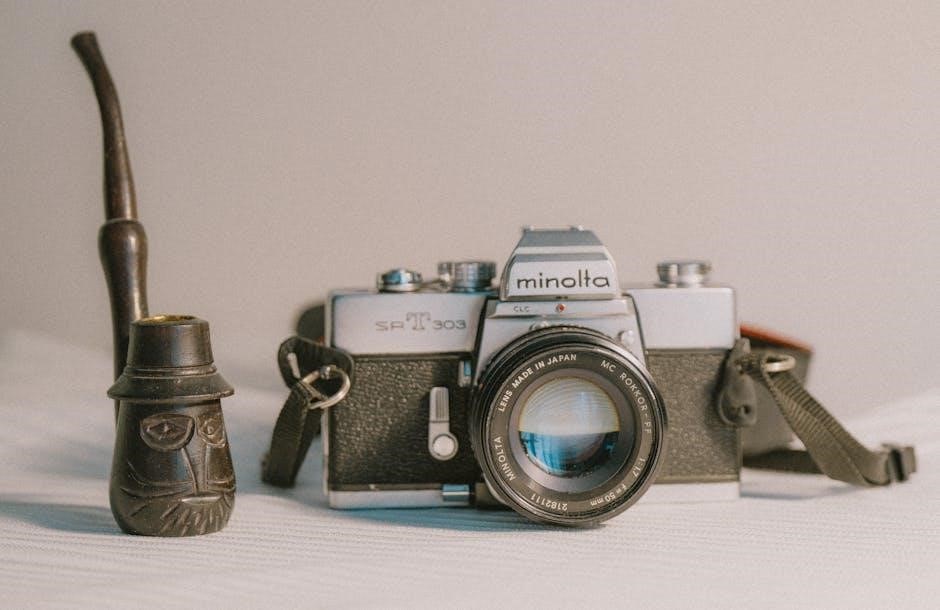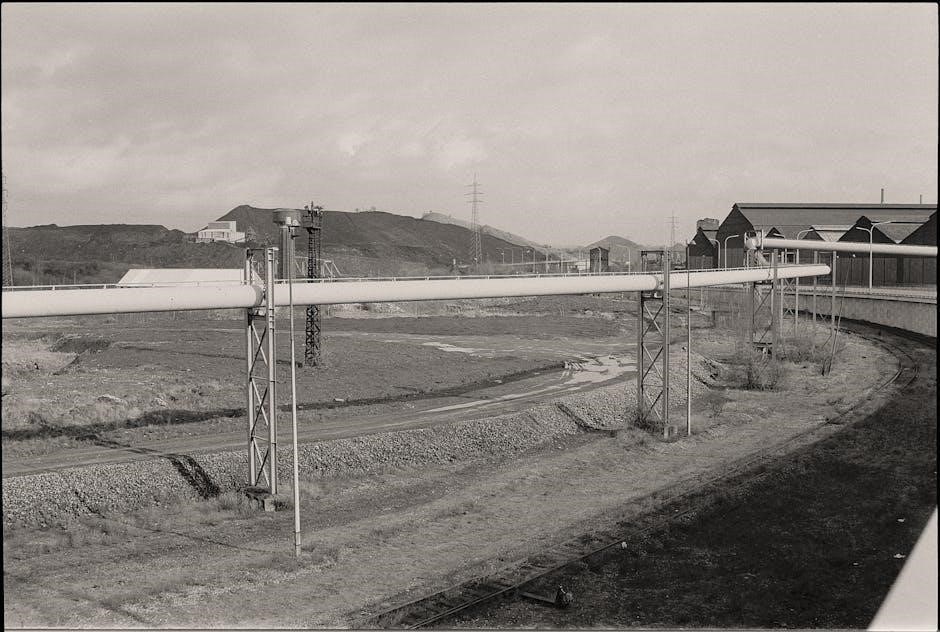Manual pipe notchers are essential tools in pipe fitting and fabrication, enabling precise notching for seamless pipe fitting and welding. They are efficient, portable, and cost-effective, ideal for various industries requiring accurate tube modifications.
1.1 Definition and Purpose
A manual pipe notcher is a handheld or portable tool designed to create precise notches in pipes or tubes. Its primary purpose is to prepare pipes for fitting and welding by creating smooth, accurate cuts. This tool is essential for ensuring secure connections and proper fitting in various piping systems. Manual notchers are known for their portability, ease of use, and cost-effectiveness, making them ideal for small-scale projects and industries like HVAC, plumbing, and automotive. They offer a simple yet efficient solution for achieving professional-grade notches without the need for advanced machinery.
1.2 Importance in Pipe Fitting and Fabrication
Manual pipe notchers play a crucial role in pipe fitting and fabrication by enabling precise, accurate notches that ensure secure connections and proper fitting. They are indispensable for creating smooth, professional-grade joints, which are essential for the integrity and durability of piping systems. Their ability to handle various pipe sizes and materials makes them versatile tools in industries like HVAC, automotive, and plumbing. By providing efficient and cost-effective solutions, manual notchers help reduce waste and improve the overall quality of fabricated pipe systems, making them a cornerstone in modern fabrication processes.

Types of Manual Pipe Notchers
Manual pipe notchers vary in design, with popular models like the KAKA Industrial RA-2 and Scotchman Manual Pipe Notchers offering precise notching for various pipe sizes and materials.
2.1 Manual vs. Electric Pipe Notchers
Manual pipe notchers are cost-effective, portable tools ideal for small-scale projects, offering precise control for notching pipes at specific angles. Electric pipe notchers, while more efficient for large-scale operations, require power and are less portable. Manual models, like the KAKA RA-2, are preferred for their simplicity and ease of use, making them essential for fabricators needing reliable, manual operation without reliance on electricity. This makes manual notchers a practical choice for workshops with limited resources or those prioritizing portability and ease of operation.
2.2 KAKA Industrial RA-2 Manual Pipe Notcher
The KAKA Industrial RA-2 Manual Pipe Notcher is a standout tool designed for precision and efficiency. It is capable of notching 3/4″, 1″, and 1-1/4″ schedule 40 pipes at 90 degrees, making it ideal for various fabrication tasks. Constructed with high-quality materials, including durable steel housing and chromium blades, this notcher ensures long-lasting performance. Its lightweight design enhances portability, while the self-centering vise provides accurate alignment. The RA-2 is a reliable choice for professionals seeking a manual notcher that delivers consistent results without compromising on quality or functionality.
2.3 Scotchman Manual Pipe Notchers
Scotchman manual pipe notchers are renowned for their durability and precision, offering reliable performance in various fabrication tasks. Designed for repetitive operations, these tools are ideal for notching pipes quickly and efficiently. Scotchman manual notchers feature a robust construction, ensuring long-term reliability, and come with high-quality blades that deliver clean, precise notches. They are particularly popular in industries requiring consistent results, such as HVAC and automotive. Backed by a three-year warranty, Scotchman manual pipe notchers provide excellent value for professionals seeking dependable tools for their projects.
Applications of Manual Pipe Notchers
Manual pipe notchers are versatile tools used in various industries for precise pipe modifications. They are ideal for HVAC, automotive, and general pipe fitting applications, ensuring clean, accurate notches for seamless welds and connections.
3.1 General Pipe Notching Applications
Manual pipe notchers are essential tools for various general pipe notching applications, ensuring precise and clean cuts. They are widely used in preparing pipes for welding, creating mating surfaces, and fitting pipes together seamlessly. These tools are particularly useful for notching pipes to fit against other pipes or structural components. Their ability to make accurate notches without damaging the pipe makes them indispensable in fabrication and installation processes. Whether for small-scale projects or industrial applications, manual pipe notchers provide consistent results, ensuring durability and reliability in pipe connections.
3.2 Specialized Applications in HVAC and Automotive Industries
Manual pipe notchers find specialized applications in the HVAC and automotive industries, where precise notching is critical. In HVAC systems, they are used to create custom fittings for ductwork and piping, ensuring efficient airflow and system performance. In automotive applications, these tools are essential for modifying exhaust systems, chassis components, and custom pipe installations. Their portability and precision make them ideal for workshops and fabrication shops, allowing technicians to achieve professional results quickly and efficiently. The ability to notch pipes accurately is vital for maintaining system integrity and performance in these demanding industries.

Key Features of Manual Pipe Notchers
Manual pipe notchers feature self-centering vises for precise alignment, adjustable stops for consistent angles, and durable construction for long-lasting performance. High-quality blades ensure clean, accurate notches.
4.1 Self-Centering Vise Design
The self-centering vise design in manual pipe notchers ensures accurate alignment of pipes and tubes, eliminating the need for manual adjustments. This feature guarantees consistent notching results, improving efficiency and reducing the risk of errors. The vise securely holds the material in place, allowing for precise control during the notching process. This design is particularly beneficial for repetitive tasks, as it maintains uniformity across multiple notches. The self-centering mechanism is durable and requires minimal maintenance, making it a reliable component of manual pipe notchers. Its robust construction ensures long-term performance and stability.
4.2 Adjustable Stops for Precise Angles
Manual pipe notchers often feature adjustable stops with locking pins, enabling precise angle settings for consistent notching results. These stops allow users to pre-set specific angles, such as 90 degrees, ensuring uniformity in every cut. The adjustable design enhances versatility, accommodating various pipe sizes and materials. This feature is particularly useful for repetitive tasks, as it maintains accuracy and reduces setup time. The locking mechanism ensures stability, preventing deviations during the notching process. Adjustable stops are a key advantage in manual pipe notchers, offering both precision and efficiency for professional-grade results.
4.4 Durable Construction and Materials
Manual pipe notchers are built with durable materials, such as fully-machined steel housings, ensuring long-lasting performance in demanding environments. High-quality chromium blades provide excellent cutting results and resist wear. The robust construction withstands heavy use, making these tools reliable for industrial and workshop applications. Many models feature lightweight yet sturdy designs, enhancing portability without compromising durability. These tools are designed to endure rigorous tasks, ensuring consistent performance and extending their service life. The use of premium materials guarantees that manual pipe notchers remain effective and dependable for years of continuous use.

How to Choose the Right Manual Pipe Notcher
When selecting a manual pipe notcher, consider portability, blade quality, and adjustable stops for precise angles. Ensure it suits your pipe size and material needs.
5.1 Factors to Consider: Pipe Size and Material
When choosing a manual pipe notcher, pipe size and material are crucial. Ensure the tool accommodates the pipe’s outer diameter and thickness. For instance, notching schedule 40 pipes requires a notcher capable of handling specific diameters, such as 1.5″ or 2″; Additionally, the material, whether steel, stainless steel, or another alloy, affects the notcher’s compatibility. Always verify the tool’s specifications to match your project requirements. Proper alignment ensures precision and efficiency.
5.2 Importance of Blade Quality and Replaceability
Blade quality and replaceability are critical factors for manual pipe notchers. High-quality blades, often made of durable materials like chromium, ensure clean and precise notches. Dull or low-quality blades can lead to uneven cuts, reducing the tool’s efficiency. Additionally, replaceable blades extend the tool’s lifespan, allowing users to maintain performance without replacing the entire unit. Look for notchers with easily interchangeable blades to save costs and ensure consistent results over time. This feature is especially important for frequent or heavy-duty applications, where blade wear is accelerated.

Maintenance and Care Tips
Regular cleaning and lubrication of moving parts ensure smooth operation. Sharpen or replace blades when worn to maintain precision. Store the tool in a dry, secure location to prevent damage.
6.1 Regular Cleaning and Lubrication
Regular cleaning and lubrication are vital to maintain the performance of manual pipe notchers. Use a soft cloth to wipe down surfaces, removing dirt and debris. Apply a light machine oil to moving parts to prevent rust and friction. This ensures smooth operation and extends the tool’s lifespan. Lubrication also helps protect against corrosion, keeping the notcher in optimal condition for precise notching. Regular maintenance prevents wear and tear, ensuring consistent results in pipe fitting and fabrication tasks. Cleanliness and proper lubrication are essential for reliable and efficient tool performance.
6.2 Blade Sharpening and Replacement
Proper blade maintenance is crucial for manual pipe notchers. Regularly inspect blades for wear and dullness, sharpening them when necessary to maintain precision. Use a diamond stone or file to sharpen edges, ensuring the original angle is preserved. Replace blades when they become excessively worn or damaged. High-quality blades, often made of materials like chromium, are designed for durability but will eventually need replacement. Always follow manufacturer guidelines for sharpening and replacing blades to ensure optimal performance and extend the tool’s lifespan. Proper blade care enhances cutting accuracy and overall tool efficiency.